-
算法基础13:数结构
基础部分
为什么要学习树结构
-
数组存储方式的分析
优点:通过下标方式访问元素,速度快。对于有序数组,还可使用二分查找提高检素速度。
缺点:如果要检素具体某个值,或者插入值(按一定顺序)会整体移动,效率较低。
-
链式存储方式的分析
优点:在一定程度上对数组存储方式有优化(比如:插入一个数值节点,只需要将插入节点,链接到链表中即可,删除效率也很好)。
缺点:在进行检素时,效率仍然较低,比如(检素某个值,需要从头节点开始遍历)
-
树存储方式的分析
能提高数据存储,读取的效率,比如利用二叉排序树(Binary Sort Tree),既可以保证数据的检索速度,同时也可以保证数据的插入,别除,修改的速度。
案例:[7,3,10,1,5,9,12]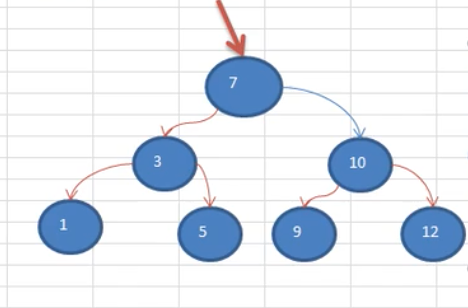
常用术语
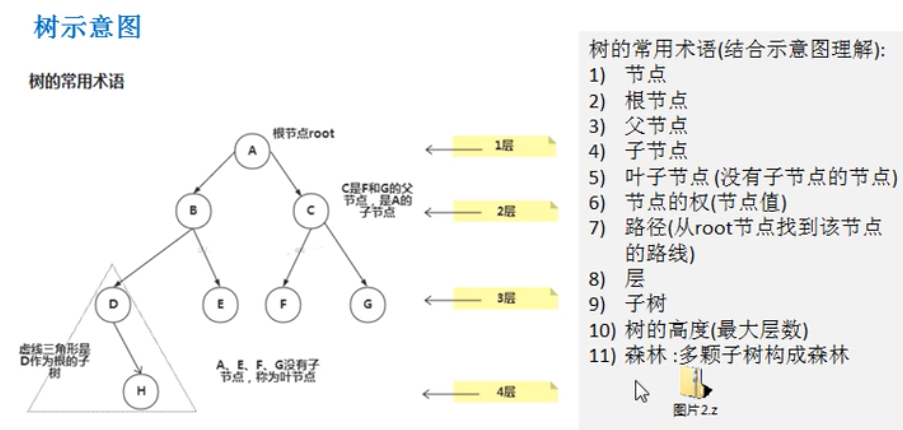
二叉树
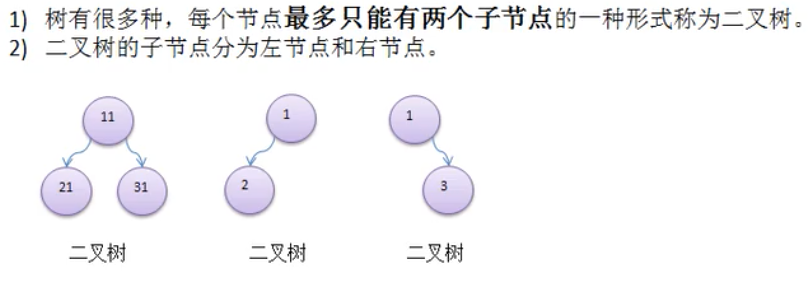
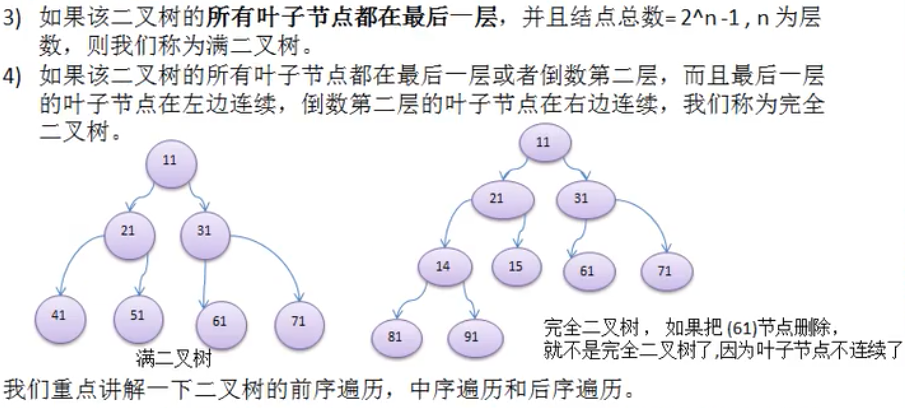
二叉树的遍历
需求说明
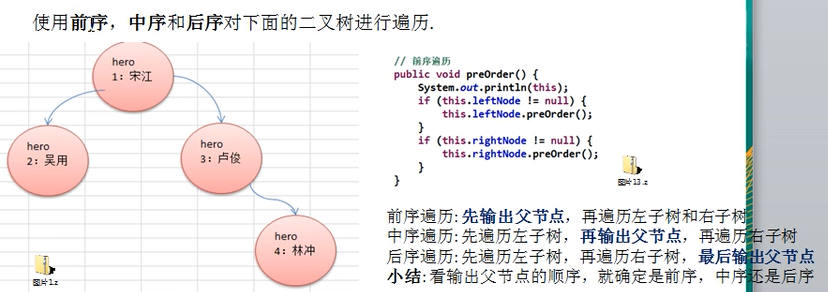
二叉树的遍历思路分析
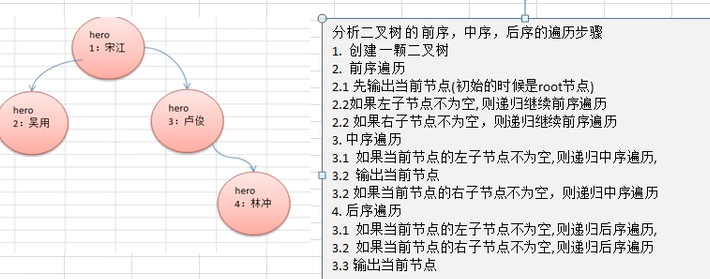
前序遍历、中序遍历、后序遍历 代码
public class BinaryTreeDemo { public static void main(String[] args) { BinaryTree binaryTree = new BinaryTree(); HeroNode node1 = new HeroNode(1, "宋江"); HeroNode node2 = new HeroNode(2, "无用"); HeroNode node3 = new HeroNode(3, "卢俊义"); HeroNode node4 = new HeroNode(4, "林冲"); // HeroNode node5 = new HeroNode(5, "关胜"); node1.setLeft(node2); node1.setRight(node3); node3.setRight(node4); // node3.setLeft(node5); binaryTree.setRoot(node1); System.out.println("前序遍历"); binaryTree.preOrder(); System.out.println("中序遍历"); binaryTree.infixOrder(); System.out.println("中序遍历"); binaryTree.postOrder(); } } class BinaryTree { private HeroNode root; public void setRoot(HeroNode root) { this.root = root; } public void preOrder() { if (this.root != null) { this.root.preOrder(); } else { System.out.println("二叉树为空,无法遍历"); } } public void infixOrder() { if (this.root != null) { this.root.infixOrder(); } else { System.out.println("二叉树为空,无法遍历"); } } public void postOrder() { if (this.root != null) { this.root.postOrder(); } else { System.out.println("二叉树为空,无法遍历"); } } } class HeroNode { private int no; private String name; private HeroNode left; private HeroNode right; @Override public String toString() { return "HeroNode{" + "no=" + no + ", name='" + name + '\'' + '}'; } public HeroNode(int no, String name) { this.no = no; this.name = name; } public int getNo() { return no; } public void setNo(int no) { this.no = no; } public String getName() { return name; } public void setName(String name) { this.name = name; } public HeroNode getLeft() { return left; } public void setLeft(HeroNode left) { this.left = left; } public HeroNode getRight() { return right; } public void setRight(HeroNode right) { this.right = right; } //前序遍历方法 public void preOrder() { //先输出父节点 System.out.println(this); //递归向左子树前序遍历 if (this.left != null) { this.left.preOrder(); } //递归向右子树前序遍历 if (this.right != null) { this.right.preOrder(); } } //中序遍历方法 public void infixOrder() { //递归向左子树前序遍历 if (this.left != null) { this.left.infixOrder(); } //先输出父节点 System.out.println(this); //递归向右子树前序遍历 if (this.right != null) { this.right.infixOrder(); } } //后序遍历方法 public void postOrder() { //递归向左子树前序遍历 if (this.left != null) { this.left.postOrder(); } //递归向右子树前序遍历 if (this.right != null) { this.right.postOrder(); } //先输出父节点 System.out.println(this); } }- 1
- 2
- 3
- 4
- 5
- 6
- 7
- 8
- 9
- 10
- 11
- 12
- 13
- 14
- 15
- 16
- 17
- 18
- 19
- 20
- 21
- 22
- 23
- 24
- 25
- 26
- 27
- 28
- 29
- 30
- 31
- 32
- 33
- 34
- 35
- 36
- 37
- 38
- 39
- 40
- 41
- 42
- 43
- 44
- 45
- 46
- 47
- 48
- 49
- 50
- 51
- 52
- 53
- 54
- 55
- 56
- 57
- 58
- 59
- 60
- 61
- 62
- 63
- 64
- 65
- 66
- 67
- 68
- 69
- 70
- 71
- 72
- 73
- 74
- 75
- 76
- 77
- 78
- 79
- 80
- 81
- 82
- 83
- 84
- 85
- 86
- 87
- 88
- 89
- 90
- 91
- 92
- 93
- 94
- 95
- 96
- 97
- 98
- 99
- 100
- 101
- 102
- 103
- 104
- 105
- 106
- 107
- 108
- 109
- 110
- 111
- 112
- 113
- 114
- 115
- 116
- 117
- 118
- 119
- 120
- 121
- 122
- 123
- 124
- 125
- 126
- 127
- 128
- 129
- 130
- 131
- 132
- 133
- 134
- 135
- 136
- 137
- 138
- 139
- 140
- 141
- 142
- 143
- 144
- 145
- 146
- 147
- 148
- 149
- 150
- 151
- 152
- 153
- 154
- 155
- 156
输出结果
前序遍历
HeroNode{no=1, name='宋江'} HeroNode{no=2, name='无用'} HeroNode{no=3, name='卢俊义'} HeroNode{no=4, name='林冲'} 中序遍历 HeroNode{no=2, name='无用'} HeroNode{no=1, name='宋江'} HeroNode{no=3, name='卢俊义'} HeroNode{no=4, name='林冲'} 中序遍历 HeroNode{no=2, name='无用'} HeroNode{no=4, name='林冲'} HeroNode{no=3, name='卢俊义'} HeroNode{no=1, name='宋江'}- 1
- 2
- 3
- 4
- 5
- 6
- 7
- 8
- 9
- 10
- 11
- 12
- 13
- 14
二叉树的查找
需求说明
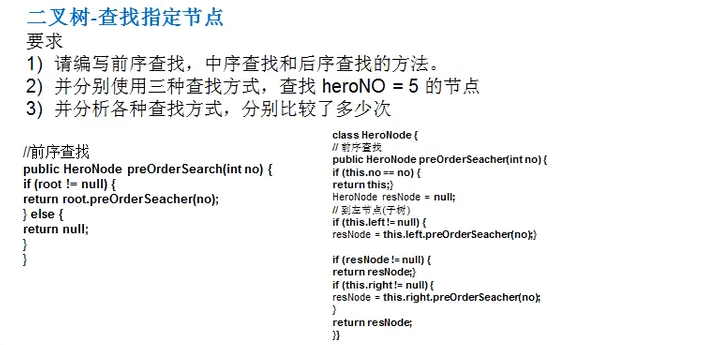
思路分析
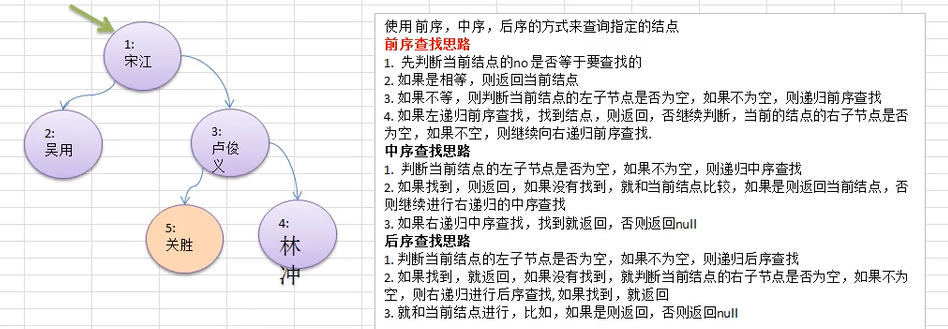
前序查找、中序查找、后序查找 代码
public class BinaryTreeDemo { public static void main(String[] args) { BinaryTree binaryTree = new BinaryTree(); HeroNode node1 = new HeroNode(1, "宋江"); HeroNode node2 = new HeroNode(2, "无用"); HeroNode node3 = new HeroNode(3, "卢俊义"); HeroNode node4 = new HeroNode(4, "林冲"); // HeroNode node5 = new HeroNode(5, "关胜"); node1.setLeft(node2); node1.setRight(node3); node3.setRight(node4); // node3.setLeft(node5); binaryTree.setRoot(node1); // // System.out.println("前序遍历"); // binaryTree.preOrder(); // // System.out.println("中序遍历"); // binaryTree.infixOrder(); // // System.out.println("中序遍历"); // binaryTree.postOrder(); System.out.println("前序遍历"); HeroNode heroNode1 = binaryTree.preOrderSearch(2); System.out.println(heroNode1); System.out.println("中序遍历"); HeroNode heroNode2 = binaryTree.infixOrderSearch(3); System.out.println(heroNode2); System.out.println("中序遍历"); HeroNode heroNode3 = binaryTree.postOrderSearch(4); System.out.println(heroNode3); } } class BinaryTree { private HeroNode root; public void setRoot(HeroNode root) { this.root = root; } public void preOrder() { if (this.root != null) { this.root.preOrder(); } else { System.out.println("二叉树为空,无法遍历"); } } public void infixOrder() { if (this.root != null) { this.root.infixOrder(); } else { System.out.println("二叉树为空,无法遍历"); } } public void postOrder() { if (this.root != null) { this.root.postOrder(); } else { System.out.println("二叉树为空,无法遍历"); } } public HeroNode preOrderSearch(int no) { HeroNode heroNode = null; if (this.root != null) { heroNode = this.root.preOrderSearch(no); } else { System.out.println("二叉树为空,无法查找"); } return heroNode; } public HeroNode infixOrderSearch(int no) { HeroNode heroNode = null; if (this.root != null) { heroNode = this.root.infixOrderSearch(no); } else { System.out.println("二叉树为空,无法查找"); } return heroNode; } public HeroNode postOrderSearch(int no) { HeroNode heroNode = null; if (this.root != null) { heroNode = this.root.postOrderSearch(no); } else { System.out.println("二叉树为空,无法查找"); } return heroNode; } } class HeroNode { private int no; private String name; private HeroNode left; private HeroNode right; @Override public String toString() { return "HeroNode{" + "no=" + no + ", name='" + name + '\'' + '}'; } public HeroNode(int no, String name) { this.no = no; this.name = name; } public int getNo() { return no; } public void setNo(int no) { this.no = no; } public String getName() { return name; } public void setName(String name) { this.name = name; } public HeroNode getLeft() { return left; } public void setLeft(HeroNode left) { this.left = left; } public HeroNode getRight() { return right; } public void setRight(HeroNode right) { this.right = right; } //前序遍历方法 public void preOrder() { //先输出父节点 System.out.println(this); //递归向左子树前序遍历 if (this.left != null) { this.left.preOrder(); } //递归向右子树前序遍历 if (this.right != null) { this.right.preOrder(); } } //中序遍历方法 public void infixOrder() { //递归向左子树前序遍历 if (this.left != null) { this.left.infixOrder(); } //先输出父节点 System.out.println(this); //递归向右子树前序遍历 if (this.right != null) { this.right.infixOrder(); } } //后序遍历方法 public void postOrder() { //递归向左子树前序遍历 if (this.left != null) { this.left.postOrder(); } //递归向右子树前序遍历 if (this.right != null) { this.right.postOrder(); } //先输出父节点 System.out.println(this); } /** * 前序查找 * * @param no 查找条件 编号 * @return 如果返回节点信息 没有找到返回null */ public HeroNode preOrderSearch(int no) { if (this.no == no) { return this; } //1,则判断当前结点的左子节点是否为空,如果不为空,则递归前序查找 //2,如果左递归前序查找,找到结点,则返回 HeroNode resNode = null; if (this.left != null) { resNode = this.left.preOrderSearch(no); } if (resNode != null) { return resNode; } //1,左递归前序查找,找到结点,则返回,否继续判断, //2,当前的结点的右子节点是否为空,如果不空,则继续向右递归前序查找 if (this.right != null) { resNode = this.right.preOrderSearch(no); } return resNode; } /** * 中序查找 * * @param no 查找条件 编号 * @return 如果返回节点信息 没有找到返回null */ public HeroNode infixOrderSearch(int no) { //判断当前结点的左子节点是否为空,如果不为空,则递归中序查找 HeroNode resNode = null; if (this.left != null) { resNode = this.left.infixOrderSearch(no); } if (resNode != null) { return resNode; } //如果找到,则返回,如果没有找到,就和当前结点比较,如果是则返回当前结点 if (this.no == no) { return this; } if (this.right != null) { resNode = this.right.infixOrderSearch(no); } return resNode; } /** * 中序查找 * * @param no 查找条件 编号 * @return 如果返回节点信息 没有找到返回null */ public HeroNode postOrderSearch(int no) { //判断当前结点的左子节点是否为空,如果不为空,则递归中序查找 HeroNode resNode = null; if (this.left != null) { resNode = this.left.postOrderSearch(no); } if (resNode != null) { return resNode; } if (this.right != null) { resNode = this.right.infixOrderSearch(no); } if (resNode != null) { return resNode; } //如果找到,则返回,如果没有找到,就和当前结点比较,如果是则返回当前结点 if (this.no == no) { return this; } return resNode; } }- 1
- 2
- 3
- 4
- 5
- 6
- 7
- 8
- 9
- 10
- 11
- 12
- 13
- 14
- 15
- 16
- 17
- 18
- 19
- 20
- 21
- 22
- 23
- 24
- 25
- 26
- 27
- 28
- 29
- 30
- 31
- 32
- 33
- 34
- 35
- 36
- 37
- 38
- 39
- 40
- 41
- 42
- 43
- 44
- 45
- 46
- 47
- 48
- 49
- 50
- 51
- 52
- 53
- 54
- 55
- 56
- 57
- 58
- 59
- 60
- 61
- 62
- 63
- 64
- 65
- 66
- 67
- 68
- 69
- 70
- 71
- 72
- 73
- 74
- 75
- 76
- 77
- 78
- 79
- 80
- 81
- 82
- 83
- 84
- 85
- 86
- 87
- 88
- 89
- 90
- 91
- 92
- 93
- 94
- 95
- 96
- 97
- 98
- 99
- 100
- 101
- 102
- 103
- 104
- 105
- 106
- 107
- 108
- 109
- 110
- 111
- 112
- 113
- 114
- 115
- 116
- 117
- 118
- 119
- 120
- 121
- 122
- 123
- 124
- 125
- 126
- 127
- 128
- 129
- 130
- 131
- 132
- 133
- 134
- 135
- 136
- 137
- 138
- 139
- 140
- 141
- 142
- 143
- 144
- 145
- 146
- 147
- 148
- 149
- 150
- 151
- 152
- 153
- 154
- 155
- 156
- 157
- 158
- 159
- 160
- 161
- 162
- 163
- 164
- 165
- 166
- 167
- 168
- 169
- 170
- 171
- 172
- 173
- 174
- 175
- 176
- 177
- 178
- 179
- 180
- 181
- 182
- 183
- 184
- 185
- 186
- 187
- 188
- 189
- 190
- 191
- 192
- 193
- 194
- 195
- 196
- 197
- 198
- 199
- 200
- 201
- 202
- 203
- 204
- 205
- 206
- 207
- 208
- 209
- 210
- 211
- 212
- 213
- 214
- 215
- 216
- 217
- 218
- 219
- 220
- 221
- 222
- 223
- 224
- 225
- 226
- 227
- 228
- 229
- 230
- 231
- 232
- 233
- 234
- 235
- 236
- 237
- 238
- 239
- 240
- 241
- 242
- 243
- 244
- 245
- 246
- 247
- 248
- 249
- 250
- 251
- 252
- 253
- 254
- 255
- 256
- 257
- 258
- 259
- 260
- 261
- 262
- 263
- 264
- 265
- 266
- 267
- 268
- 269
- 270
- 271
- 272
- 273
- 274
- 275
- 276
- 277
- 278
- 279
- 280
- 281
- 282
- 283
- 284
- 285
- 286
- 287
- 288
- 289
- 290
- 291
- 292
- 293
二叉树的删除结点
需求说明
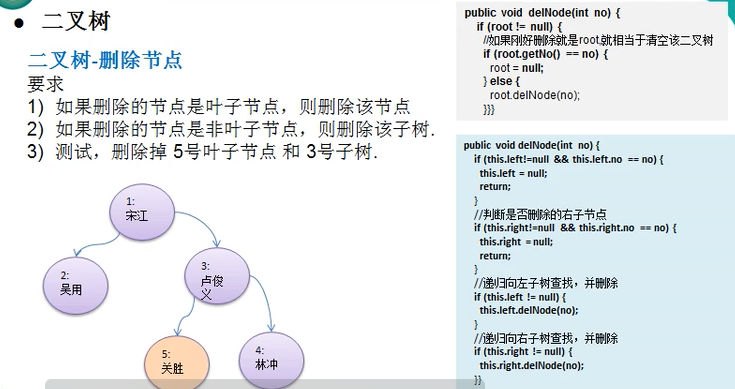
思路分析
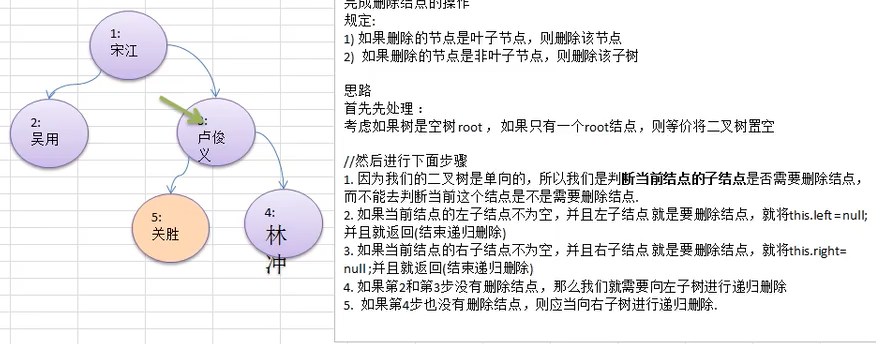
删除结点 代码
public class BinaryTreeDemo { public static void main(String[] args) { BinaryTree binaryTree = new BinaryTree(); HeroNode node1 = new HeroNode(1, "宋江"); HeroNode node2 = new HeroNode(2, "无用"); HeroNode node3 = new HeroNode(3, "卢俊义"); HeroNode node4 = new HeroNode(4, "林冲"); HeroNode node5 = new HeroNode(5, "关胜"); node1.setLeft(node2); node1.setRight(node3); node3.setRight(node4); node3.setLeft(node5); binaryTree.setRoot(node1); // // System.out.println("前序遍历"); // binaryTree.preOrder(); // // System.out.println("中序遍历"); // binaryTree.infixOrder(); // // System.out.println("中序遍历"); // binaryTree.postOrder(); // System.out.println("前序遍历"); // HeroNode heroNode1 = binaryTree.preOrderSearch(2); // System.out.println(heroNode1); // // System.out.println("中序遍历"); // HeroNode heroNode2 = binaryTree.infixOrderSearch(3); // System.out.println(heroNode2); // // System.out.println("中序遍历"); // HeroNode heroNode3 = binaryTree.postOrderSearch(4); // System.out.println(heroNode3); System.out.println("删除前"); binaryTree.infixOrder(); binaryTree.delOrder(3); System.out.println("删除后"); binaryTree.infixOrder(); } } class BinaryTree { private HeroNode root; public void setRoot(HeroNode root) { this.root = root; } public void delOrder(int no) { if (this.root != null) { this.root.delNode(no); } else { System.out.println("二叉树为空,无法删除"); } } public void preOrder() { if (this.root != null) { this.root.preOrder(); } else { System.out.println("二叉树为空,无法遍历"); } } public void infixOrder() { if (this.root != null) { this.root.infixOrder(); } else { System.out.println("二叉树为空,无法遍历"); } } public void postOrder() { if (this.root != null) { this.root.postOrder(); } else { System.out.println("二叉树为空,无法遍历"); } } public HeroNode preOrderSearch(int no) { HeroNode heroNode = null; if (this.root != null) { heroNode = this.root.preOrderSearch(no); } else { System.out.println("二叉树为空,无法查找"); } return heroNode; } public HeroNode infixOrderSearch(int no) { HeroNode heroNode = null; if (this.root != null) { heroNode = this.root.infixOrderSearch(no); } else { System.out.println("二叉树为空,无法查找"); } return heroNode; } public HeroNode postOrderSearch(int no) { HeroNode heroNode = null; if (this.root != null) { heroNode = this.root.postOrderSearch(no); } else { System.out.println("二叉树为空,无法查找"); } return heroNode; } } class HeroNode { private int no; private String name; private HeroNode left; private HeroNode right; @Override public String toString() { return "HeroNode{" + "no=" + no + ", name='" + name + '\'' + '}'; } public HeroNode(int no, String name) { this.no = no; this.name = name; } public int getNo() { return no; } public void setNo(int no) { this.no = no; } public String getName() { return name; } public void setName(String name) { this.name = name; } public HeroNode getLeft() { return left; } public void setLeft(HeroNode left) { this.left = left; } public HeroNode getRight() { return right; } public void setRight(HeroNode right) { this.right = right; } //递归删除结点 //1,如果删除的节点是叶子节点,则侧删除该节点 //2,如果删除的节点是非叶子节点,则删除该子树 public void delNode(int no) { //思路 /* 1。因为我们的二叉树是单向的,所以我们是判断当前结点的子结点是否需要删除结点,而不能去判断当前这个结点是不是需要删除结, 2。如果当前结点的左子结点不为空,并且左子结点就是要删除结点,就将this.1eft=null;并且就返回(结束递归删除) 3,如果当前结点的右子结点不为空,并且右子结点就是要删除结点,就将this,right=ul1;并且就返回(结束递归删除) 4。如果第2和第3步没有删除结点,那么我们就需要向左子树进行递归删除 5。如果第4步也没有删除结点,则应当向右子树进行递归删除, */ //2如果当前结点的左子结点不为空,并且左子结点就是要删除结点,就将this,1eft=nu11;并且就返回(结束递归删除) if (this.left != null && this.left.no == no){ this.left = null; return; } //3,如果当前结点的右子结点不为空,并且右子结点就是要删除结点,就将this,right=nu11;并且就返回(结束递归删除) if (this.right != null && this.right.no == no){ this.right = null; return; } //4,我们就需要向左子树进行递归删除 if (this.left != null){ this.left.delNode(no); } //5 if (this.right != null){ this.right.delNode(no); } } //前序遍历方法 public void preOrder() { //先输出父节点 System.out.println(this); //递归向左子树前序遍历 if (this.left != null) { this.left.preOrder(); } //递归向右子树前序遍历 if (this.right != null) { this.right.preOrder(); } } //中序遍历方法 public void infixOrder() { //递归向左子树前序遍历 if (this.left != null) { this.left.infixOrder(); } //先输出父节点 System.out.println(this); //递归向右子树前序遍历 if (this.right != null) { this.right.infixOrder(); } } //后序遍历方法 public void postOrder() { //递归向左子树前序遍历 if (this.left != null) { this.left.postOrder(); } //递归向右子树前序遍历 if (this.right != null) { this.right.postOrder(); } //先输出父节点 System.out.println(this); } /** * 前序查找 * * @param no 查找条件 编号 * @return 如果返回节点信息 没有找到返回null */ public HeroNode preOrderSearch(int no) { if (this.no == no) { return this; } //1,则判断当前结点的左子节点是否为空,如果不为空,则递归前序查找 //2,如果左递归前序查找,找到结点,则返回 HeroNode resNode = null; if (this.left != null) { resNode = this.left.preOrderSearch(no); } if (resNode != null) { return resNode; } //1,左递归前序查找,找到结点,则返回,否继续判断, //2,当前的结点的右子节点是否为空,如果不空,则继续向右递归前序查找 if (this.right != null) { resNode = this.right.preOrderSearch(no); } return resNode; } /** * 中序查找 * * @param no 查找条件 编号 * @return 如果返回节点信息 没有找到返回null */ public HeroNode infixOrderSearch(int no) { //判断当前结点的左子节点是否为空,如果不为空,则递归中序查找 HeroNode resNode = null; if (this.left != null) { resNode = this.left.infixOrderSearch(no); } if (resNode != null) { return resNode; } //如果找到,则返回,如果没有找到,就和当前结点比较,如果是则返回当前结点 if (this.no == no) { return this; } if (this.right != null) { resNode = this.right.infixOrderSearch(no); } return resNode; } /** * 中序查找 * * @param no 查找条件 编号 * @return 如果返回节点信息 没有找到返回null */ public HeroNode postOrderSearch(int no) { //判断当前结点的左子节点是否为空,如果不为空,则递归中序查找 HeroNode resNode = null; if (this.left != null) { resNode = this.left.postOrderSearch(no); } if (resNode != null) { return resNode; } if (this.right != null) { resNode = this.right.infixOrderSearch(no); } if (resNode != null) { return resNode; } //如果找到,则返回,如果没有找到,就和当前结点比较,如果是则返回当前结点 if (this.no == no) { return this; } return resNode; } }- 1
- 2
- 3
- 4
- 5
- 6
- 7
- 8
- 9
- 10
- 11
- 12
- 13
- 14
- 15
- 16
- 17
- 18
- 19
- 20
- 21
- 22
- 23
- 24
- 25
- 26
- 27
- 28
- 29
- 30
- 31
- 32
- 33
- 34
- 35
- 36
- 37
- 38
- 39
- 40
- 41
- 42
- 43
- 44
- 45
- 46
- 47
- 48
- 49
- 50
- 51
- 52
- 53
- 54
- 55
- 56
- 57
- 58
- 59
- 60
- 61
- 62
- 63
- 64
- 65
- 66
- 67
- 68
- 69
- 70
- 71
- 72
- 73
- 74
- 75
- 76
- 77
- 78
- 79
- 80
- 81
- 82
- 83
- 84
- 85
- 86
- 87
- 88
- 89
- 90
- 91
- 92
- 93
- 94
- 95
- 96
- 97
- 98
- 99
- 100
- 101
- 102
- 103
- 104
- 105
- 106
- 107
- 108
- 109
- 110
- 111
- 112
- 113
- 114
- 115
- 116
- 117
- 118
- 119
- 120
- 121
- 122
- 123
- 124
- 125
- 126
- 127
- 128
- 129
- 130
- 131
- 132
- 133
- 134
- 135
- 136
- 137
- 138
- 139
- 140
- 141
- 142
- 143
- 144
- 145
- 146
- 147
- 148
- 149
- 150
- 151
- 152
- 153
- 154
- 155
- 156
- 157
- 158
- 159
- 160
- 161
- 162
- 163
- 164
- 165
- 166
- 167
- 168
- 169
- 170
- 171
- 172
- 173
- 174
- 175
- 176
- 177
- 178
- 179
- 180
- 181
- 182
- 183
- 184
- 185
- 186
- 187
- 188
- 189
- 190
- 191
- 192
- 193
- 194
- 195
- 196
- 197
- 198
- 199
- 200
- 201
- 202
- 203
- 204
- 205
- 206
- 207
- 208
- 209
- 210
- 211
- 212
- 213
- 214
- 215
- 216
- 217
- 218
- 219
- 220
- 221
- 222
- 223
- 224
- 225
- 226
- 227
- 228
- 229
- 230
- 231
- 232
- 233
- 234
- 235
- 236
- 237
- 238
- 239
- 240
- 241
- 242
- 243
- 244
- 245
- 246
- 247
- 248
- 249
- 250
- 251
- 252
- 253
- 254
- 255
- 256
- 257
- 258
- 259
- 260
- 261
- 262
- 263
- 264
- 265
- 266
- 267
- 268
- 269
- 270
- 271
- 272
- 273
- 274
- 275
- 276
- 277
- 278
- 279
- 280
- 281
- 282
- 283
- 284
- 285
- 286
- 287
- 288
- 289
- 290
- 291
- 292
- 293
- 294
- 295
- 296
- 297
- 298
- 299
- 300
- 301
- 302
- 303
- 304
- 305
- 306
- 307
- 308
- 309
- 310
- 311
- 312
- 313
- 314
- 315
- 316
- 317
- 318
- 319
- 320
- 321
- 322
- 323
- 324
- 325
- 326
- 327
- 328
- 329
- 330
- 331
- 332
- 333
- 334
- 335
- 336
- 337
- 338
- 339
- 340
- 341
- 342
- 343
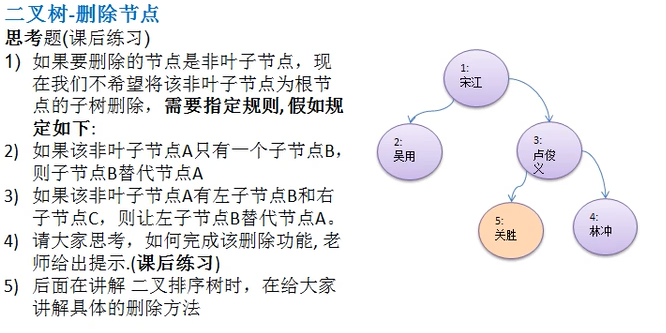
顺序存储二叉树
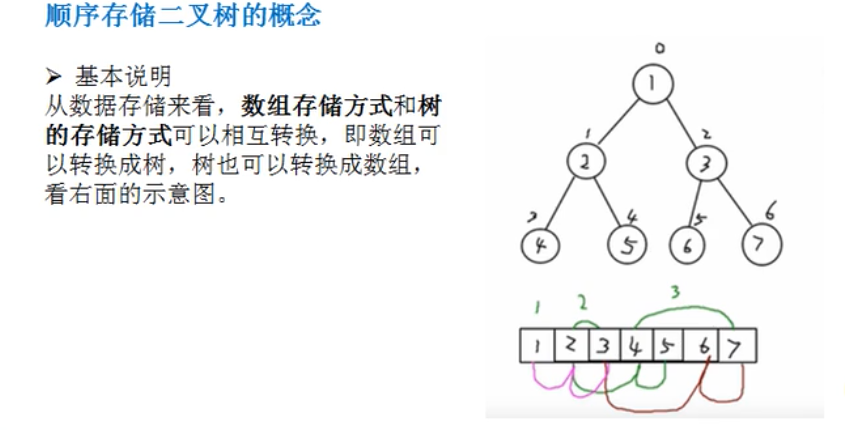
要求:
- 右图的二叉树的结点,要求以数组的方式来存放arr:[1,2,3,4,5,6,6]
- 要求在遍历数组arr时,仍然可以以前序遍历,中序遍历和后序遍历的方式完成结点的遍历
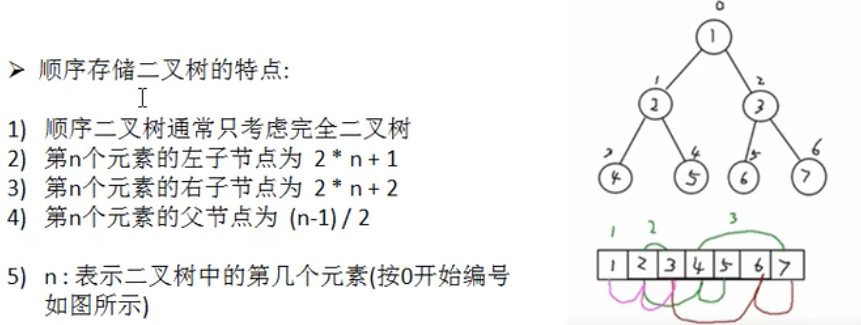
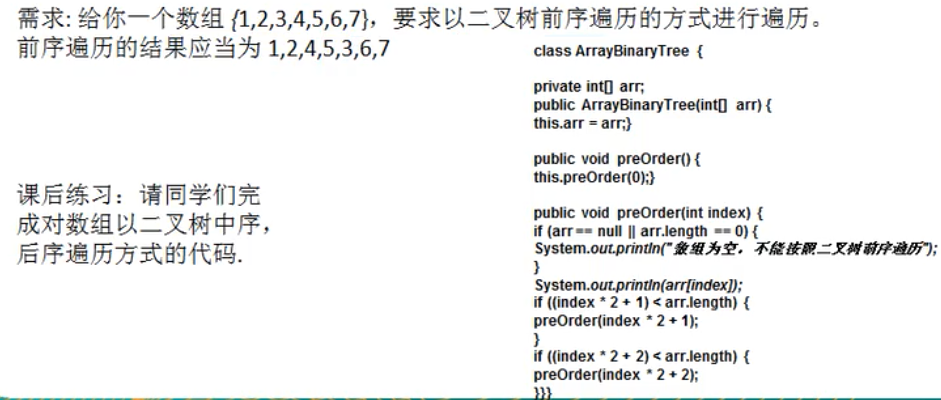
代码实现 (前序遍历)
public class ArrBinaryTreeDemo { public static void main(String[] args) { int[] arr = {1, 2, 3, 4, 5, 6, 7}; ArrBinaryTree arrBinaryTree = new ArrBinaryTree(arr); arrBinaryTree.preOrder();//1 2 4 5 3 6 7 } } //编写一个ArrayBinaryTree,实现顺序存储二叉树遍历 class ArrBinaryTree { //存储数据节点的数据 private int[] arr; public ArrBinaryTree(int[] arr) { this.arr = arr; } public void preOrder(){ this.preOrder(0); } /** * 编写一个方法,完成顺序存储二叉树的前序遍历 * * @param index 数组下标 */ public void preOrder(int index) { //如果数组为空,或者arr,length=0 if (arr == null || arr.length == 0) { System.out.println("数组为空,不能按照二叉树的前序遍历"); } //输出当前这个元素 System.out.println(arr[index]); //向左递归遍历 if ((2 * index + 1) < arr.length) { preOrder(2 * index + 1); } //向右递归遍历 if ((2 * index + 2) < arr.length) { preOrder(2 * index + 2); } } }- 1
- 2
- 3
- 4
- 5
- 6
- 7
- 8
- 9
- 10
- 11
- 12
- 13
- 14
- 15
- 16
- 17
- 18
- 19
- 20
- 21
- 22
- 23
- 24
- 25
- 26
- 27
- 28
- 29
- 30
- 31
- 32
- 33
- 34
- 35
- 36
- 37
- 38
- 39
- 40
- 41
- 42
- 43
- 44
- 45
- 46
中序遍历、后序遍历 就不写了
顺序存储二叉树应用实例
八大排序算法中的堆排序,就会使用到顺序存储二叉树,关于堆排序,我们放在<<树结构实际应用>>章节讲解。线索化二叉树
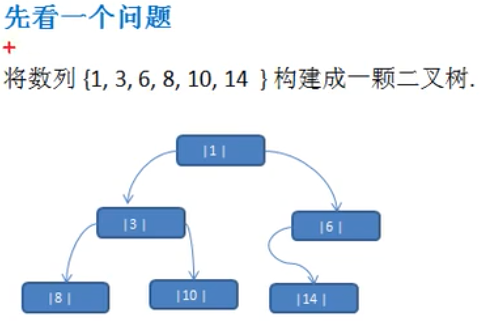
问题分析:
- 当我们对上面的二叉树进行中序遍历时,数列为8,3,10,1,6,14}
- 但是6,8,10,14这几个节点的左右指针,并没有完全的利用上
- 如果我们希望充分的利用各个节点的左右指针,让各个节点可以指向自己的前后节点怎么办?
- 解决方案 线索二又树

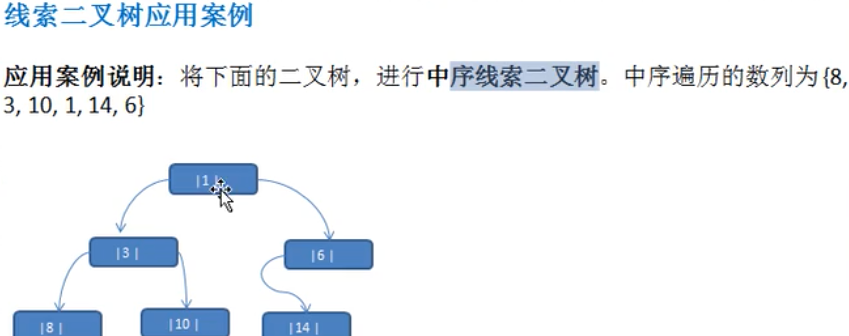
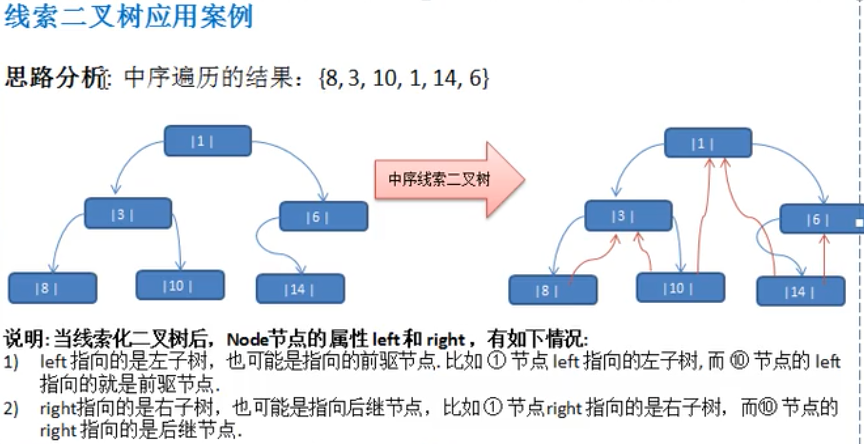
代码实现(比较难理解)
public class TreadedBinaryTreeDemo { public static void main(String[] args) { HeroNode node1 = new HeroNode(1, "宋江"); HeroNode node3 = new HeroNode(3, "吴用"); HeroNode node6 = new HeroNode(6, "卢俊义"); HeroNode node8 = new HeroNode(8, "林冲"); HeroNode node10 = new HeroNode(10, "关胜"); HeroNode node14 = new HeroNode(14, "武松"); node1.setLeft(node3); node1.setRight(node6); node3.setLeft(node8); node3.setRight(node10); node6.setLeft(node14); TreadedBinaryTree binaryTree = new TreadedBinaryTree(); binaryTree.setRoot(node1); binaryTree.treadedNodes(); HeroNode node10Left = node10.getLeft(); System.out.println("node10 前驱:" + node10Left); HeroNode node10Right = node10.getRight(); System.out.println("node10 后驱:" + node10Right); } } class TreadedBinaryTree { private HeroNode root; //为了实现线索化,需要创建要给指向当前结点的前驱结点的指针 //在递归进行线索化时,pre总是保留前一个结点 private HeroNode pre = null; public void setRoot(HeroNode root) { this.root = root; } public void treadedNodes() { this.treadedNodes(root); } /** * //编写对二叉树进行中序线索化的方法 * * @param node 就是当前需要线索化的结点 */ public void treadedNodes(HeroNode node) { //如果node==nu1ll,不能线素化 if (node == null) { return; } ///(一)先线素化左子树 treadedNodes(node.getLeft()); //(二)线素化当前结点[有难度] //处理当前结点的前驱结点 if (node.getLeft() == null) { //让当前结点的左指针指向前驱结点 node.setLeft(pre); //修改当前结点的左指针的类型 node.setLeftType(1); } //处理后继结点 if (pre != null && pre.getRight() == null) { pre.setRight(node); pre.setRightType(1); } //!!!每处理一个结点后,让当前结点是下一个结点的前驱结点 pre = node; //(三)在线索化右子树 treadedNodes(node.getRight()); } public void delOrder(int no) { if (this.root != null) { this.root.delNode(no); } else { System.out.println("二叉树为空,无法删除"); } } public void preOrder() { if (this.root != null) { this.root.preOrder(); } else { System.out.println("二叉树为空,无法遍历"); } } public void infixOrder() { if (this.root != null) { this.root.infixOrder(); } else { System.out.println("二叉树为空,无法遍历"); } } public void postOrder() { if (this.root != null) { this.root.postOrder(); } else { System.out.println("二叉树为空,无法遍历"); } } public HeroNode preOrderSearch(int no) { HeroNode heroNode = null; if (this.root != null) { heroNode = this.root.preOrderSearch(no); } else { System.out.println("二叉树为空,无法查找"); } return heroNode; } public HeroNode infixOrderSearch(int no) { HeroNode heroNode = null; if (this.root != null) { heroNode = this.root.infixOrderSearch(no); } else { System.out.println("二叉树为空,无法查找"); } return heroNode; } public HeroNode postOrderSearch(int no) { HeroNode heroNode = null; if (this.root != null) { heroNode = this.root.postOrderSearch(no); } else { System.out.println("二叉树为空,无法查找"); } return heroNode; } } class HeroNode { private int no; private String name; private HeroNode left; private HeroNode right; //说明 //1。如果1 eftType=0表示指向的是左子树,如果1则表示指向前驱结点 //2,如果rightType=0表示指向是右子树,如果1表示指向后继结点 private int leftType; private int rightType; @Override public String toString() { return "HeroNode{" + "no=" + no + ", name='" + name + '\'' + '}'; } public HeroNode(int no, String name) { this.no = no; this.name = name; } public int getLeftType() { return leftType; } public void setLeftType(int leftType) { this.leftType = leftType; } public int getRightType() { return rightType; } public void setRightType(int rightType) { this.rightType = rightType; } public int getNo() { return no; } public void setNo(int no) { this.no = no; } public String getName() { return name; } public void setName(String name) { this.name = name; } public HeroNode getLeft() { return left; } public void setLeft(HeroNode left) { this.left = left; } public HeroNode getRight() { return right; } public void setRight(HeroNode right) { this.right = right; } //递归删除结点 //1,如果删除的节点是叶子节点,则侧删除该节点 //2,如果删除的节点是非叶子节点,则删除该子树 public void delNode(int no) { //思路 /* 1。因为我们的二叉树是单向的,所以我们是判断当前结点的子结点是否需要删除结点,而不能去判断当前这个结点是不是需要删除结, 2。如果当前结点的左子结点不为空,并且左子结点就是要删除结点,就将this.1eft=null;并且就返回(结束递归删除) 3,如果当前结点的右子结点不为空,并且右子结点就是要删除结点,就将this,right=ul1;并且就返回(结束递归删除) 4。如果第2和第3步没有删除结点,那么我们就需要向左子树进行递归删除 5。如果第4步也没有删除结点,则应当向右子树进行递归删除, */ //2如果当前结点的左子结点不为空,并且左子结点就是要删除结点,就将this,1eft=nu11;并且就返回(结束递归删除) if (this.left != null && this.left.no == no) { this.left = null; return; } //3,如果当前结点的右子结点不为空,并且右子结点就是要删除结点,就将this,right=nu11;并且就返回(结束递归删除) if (this.right != null && this.right.no == no) { this.right = null; return; } //4,我们就需要向左子树进行递归删除 if (this.left != null) { this.left.delNode(no); } //5 if (this.right != null) { this.right.delNode(no); } } //前序遍历方法 public void preOrder() { //先输出父节点 System.out.println(this); //递归向左子树前序遍历 if (this.left != null) { this.left.preOrder(); } //递归向右子树前序遍历 if (this.right != null) { this.right.preOrder(); } } //中序遍历方法 public void infixOrder() { //递归向左子树前序遍历 if (this.left != null) { this.left.infixOrder(); } //先输出父节点 System.out.println(this); //递归向右子树前序遍历 if (this.right != null) { this.right.infixOrder(); } } //后序遍历方法 public void postOrder() { //递归向左子树前序遍历 if (this.left != null) { this.left.postOrder(); } //递归向右子树前序遍历 if (this.right != null) { this.right.postOrder(); } //先输出父节点 System.out.println(this); } /** * 前序查找 * * @param no 查找条件 编号 * @return 如果返回节点信息 没有找到返回null */ public HeroNode preOrderSearch(int no) { if (this.no == no) { return this; } //1,则判断当前结点的左子节点是否为空,如果不为空,则递归前序查找 //2,如果左递归前序查找,找到结点,则返回 HeroNode resNode = null; if (this.left != null) { resNode = this.left.preOrderSearch(no); } if (resNode != null) { return resNode; } //1,左递归前序查找,找到结点,则返回,否继续判断, //2,当前的结点的右子节点是否为空,如果不空,则继续向右递归前序查找 if (this.right != null) { resNode = this.right.preOrderSearch(no); } return resNode; } /** * 中序查找 * * @param no 查找条件 编号 * @return 如果返回节点信息 没有找到返回null */ public HeroNode infixOrderSearch(int no) { //判断当前结点的左子节点是否为空,如果不为空,则递归中序查找 HeroNode resNode = null; if (this.left != null) { resNode = this.left.infixOrderSearch(no); } if (resNode != null) { return resNode; } //如果找到,则返回,如果没有找到,就和当前结点比较,如果是则返回当前结点 if (this.no == no) { return this; } if (this.right != null) { resNode = this.right.infixOrderSearch(no); } return resNode; } /** * 中序查找 * * @param no 查找条件 编号 * @return 如果返回节点信息 没有找到返回null */ public HeroNode postOrderSearch(int no) { //判断当前结点的左子节点是否为空,如果不为空,则递归中序查找 HeroNode resNode = null; if (this.left != null) { resNode = this.left.postOrderSearch(no); } if (resNode != null) { return resNode; } if (this.right != null) { resNode = this.right.infixOrderSearch(no); } if (resNode != null) { return resNode; } //如果找到,则返回,如果没有找到,就和当前结点比较,如果是则返回当前结点 if (this.no == no) { return this; } return resNode; } }- 1
- 2
- 3
- 4
- 5
- 6
- 7
- 8
- 9
- 10
- 11
- 12
- 13
- 14
- 15
- 16
- 17
- 18
- 19
- 20
- 21
- 22
- 23
- 24
- 25
- 26
- 27
- 28
- 29
- 30
- 31
- 32
- 33
- 34
- 35
- 36
- 37
- 38
- 39
- 40
- 41
- 42
- 43
- 44
- 45
- 46
- 47
- 48
- 49
- 50
- 51
- 52
- 53
- 54
- 55
- 56
- 57
- 58
- 59
- 60
- 61
- 62
- 63
- 64
- 65
- 66
- 67
- 68
- 69
- 70
- 71
- 72
- 73
- 74
- 75
- 76
- 77
- 78
- 79
- 80
- 81
- 82
- 83
- 84
- 85
- 86
- 87
- 88
- 89
- 90
- 91
- 92
- 93
- 94
- 95
- 96
- 97
- 98
- 99
- 100
- 101
- 102
- 103
- 104
- 105
- 106
- 107
- 108
- 109
- 110
- 111
- 112
- 113
- 114
- 115
- 116
- 117
- 118
- 119
- 120
- 121
- 122
- 123
- 124
- 125
- 126
- 127
- 128
- 129
- 130
- 131
- 132
- 133
- 134
- 135
- 136
- 137
- 138
- 139
- 140
- 141
- 142
- 143
- 144
- 145
- 146
- 147
- 148
- 149
- 150
- 151
- 152
- 153
- 154
- 155
- 156
- 157
- 158
- 159
- 160
- 161
- 162
- 163
- 164
- 165
- 166
- 167
- 168
- 169
- 170
- 171
- 172
- 173
- 174
- 175
- 176
- 177
- 178
- 179
- 180
- 181
- 182
- 183
- 184
- 185
- 186
- 187
- 188
- 189
- 190
- 191
- 192
- 193
- 194
- 195
- 196
- 197
- 198
- 199
- 200
- 201
- 202
- 203
- 204
- 205
- 206
- 207
- 208
- 209
- 210
- 211
- 212
- 213
- 214
- 215
- 216
- 217
- 218
- 219
- 220
- 221
- 222
- 223
- 224
- 225
- 226
- 227
- 228
- 229
- 230
- 231
- 232
- 233
- 234
- 235
- 236
- 237
- 238
- 239
- 240
- 241
- 242
- 243
- 244
- 245
- 246
- 247
- 248
- 249
- 250
- 251
- 252
- 253
- 254
- 255
- 256
- 257
- 258
- 259
- 260
- 261
- 262
- 263
- 264
- 265
- 266
- 267
- 268
- 269
- 270
- 271
- 272
- 273
- 274
- 275
- 276
- 277
- 278
- 279
- 280
- 281
- 282
- 283
- 284
- 285
- 286
- 287
- 288
- 289
- 290
- 291
- 292
- 293
- 294
- 295
- 296
- 297
- 298
- 299
- 300
- 301
- 302
- 303
- 304
- 305
- 306
- 307
- 308
- 309
- 310
- 311
- 312
- 313
- 314
- 315
- 316
- 317
- 318
- 319
- 320
- 321
- 322
- 323
- 324
- 325
- 326
- 327
- 328
- 329
- 330
- 331
- 332
- 333
- 334
- 335
- 336
- 337
- 338
- 339
- 340
- 341
- 342
- 343
- 344
- 345
- 346
- 347
- 348
- 349
- 350
- 351
- 352
- 353
- 354
- 355
- 356
- 357
- 358
- 359
- 360
- 361
- 362
- 363
- 364
- 365
- 366
- 367
- 368
- 369
- 370
- 371
- 372
- 373
- 374
- 375
- 376
- 377
- 378
- 379
- 380
- 381
- 382
- 383
- 384
- 385
- 386
- 387
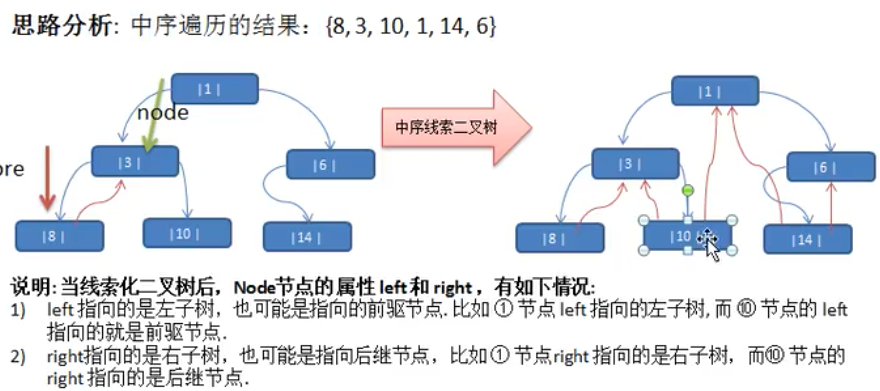
遍历线索化二叉树

/** * 线索化二叉树 * * @author:XMD * @date: 13.9.22 */ public class TreadedBinaryTreeDemo { public static void main(String[] args) { HeroNode node1 = new HeroNode(1, "宋江"); HeroNode node3 = new HeroNode(3, "吴用"); HeroNode node6 = new HeroNode(6, "卢俊义"); HeroNode node8 = new HeroNode(8, "林冲"); HeroNode node10 = new HeroNode(10, "关胜"); HeroNode node14 = new HeroNode(14, "武松"); node1.setLeft(node3); node1.setRight(node6); node3.setLeft(node8); node3.setRight(node10); node6.setLeft(node14); TreadedBinaryTree binaryTree = new TreadedBinaryTree(); binaryTree.setRoot(node1); binaryTree.treadedNodes(); HeroNode node10Left = node14.getLeft(); System.out.println("node10 前驱:" + node10Left); HeroNode node10Right = node14.getRight(); System.out.println("node10 后驱:" + node10Right); System.out.println("使用线索化的遍历遍历线索化二叉树"); binaryTree.treadedList(); } } class TreadedBinaryTree { private HeroNode root; //为了实现线索化,需要创建要给指向当前结点的前驱结点的指针 //在递归进行线索化时,pre总是保留前一个结点 private HeroNode pre = null; public void setRoot(HeroNode root) { this.root = root; } public void treadedNodes() { this.treadedNodes(root); } //遍历线索化二叉树的方法 public void treadedList() { //定义一个变量,存储当前遍历的结点,从root开始 HeroNode node = root; while (node != null) { //循环的找到1 eftType==1的结点,第一个找到就是8结点 //后面随着遍历而变化,因为当1 eftType==1时,说明该结点是按照线索化 //处理后的有效结点 while (node.getLeftType() == 0) { node = node.getLeft(); } //打印当前这个结点 System.out.println(node); //如果当前结点的右指针指向的是后继结点,就一直输出 while (node.getRightType() == 1) { //获取到当前结点的后继结点 node = node.getRight(); System.out.println(node); } //替换这个遍历的结点 node = node.getRight(); } } /** * //编写对二叉树进行中序线索化的方法 * * @param node 就是当前需要线索化的结点 */ public void treadedNodes(HeroNode node) { //如果node==nu1ll,不能线素化 if (node == null) { return; } ///(一)先线素化左子树 treadedNodes(node.getLeft()); //(二)线素化当前结点[有难度] //处理当前结点的前驱结点 if (node.getLeft() == null) { //让当前结点的左指针指向前驱结点 node.setLeft(pre); //修改当前结点的左指针的类型 node.setLeftType(1); } //处理后继结点 if (pre != null && pre.getRight() == null) { pre.setRight(node); pre.setRightType(1); } //!!!每处理一个结点后,让当前结点是下一个结点的前驱结点 pre = node; //(三)在线索化右子树 treadedNodes(node.getRight()); } public void delOrder(int no) { if (this.root != null) { this.root.delNode(no); } else { System.out.println("二叉树为空,无法删除"); } } public void preOrder() { if (this.root != null) { this.root.preOrder(); } else { System.out.println("二叉树为空,无法遍历"); } } public void infixOrder() { if (this.root != null) { this.root.infixOrder(); } else { System.out.println("二叉树为空,无法遍历"); } } public void postOrder() { if (this.root != null) { this.root.postOrder(); } else { System.out.println("二叉树为空,无法遍历"); } } public HeroNode preOrderSearch(int no) { HeroNode heroNode = null; if (this.root != null) { heroNode = this.root.preOrderSearch(no); } else { System.out.println("二叉树为空,无法查找"); } return heroNode; } public HeroNode infixOrderSearch(int no) { HeroNode heroNode = null; if (this.root != null) { heroNode = this.root.infixOrderSearch(no); } else { System.out.println("二叉树为空,无法查找"); } return heroNode; } public HeroNode postOrderSearch(int no) { HeroNode heroNode = null; if (this.root != null) { heroNode = this.root.postOrderSearch(no); } else { System.out.println("二叉树为空,无法查找"); } return heroNode; } } class HeroNode { private int no; private String name; private HeroNode left; private HeroNode right; //说明 //1。如果1 eftType=0表示指向的是左子树,如果1则表示指向前驱结点 //2,如果rightType=0表示指向是右子树,如果1表示指向后继结点 private int leftType; private int rightType; @Override public String toString() { return "HeroNode{" + "no=" + no + ", name='" + name + '\'' + '}'; } public HeroNode(int no, String name) { this.no = no; this.name = name; } public int getLeftType() { return leftType; } public void setLeftType(int leftType) { this.leftType = leftType; } public int getRightType() { return rightType; } public void setRightType(int rightType) { this.rightType = rightType; } public int getNo() { return no; } public void setNo(int no) { this.no = no; } public String getName() { return name; } public void setName(String name) { this.name = name; } public HeroNode getLeft() { return left; } public void setLeft(HeroNode left) { this.left = left; } public HeroNode getRight() { return right; } public void setRight(HeroNode right) { this.right = right; } //递归删除结点 //1,如果删除的节点是叶子节点,则侧删除该节点 //2,如果删除的节点是非叶子节点,则删除该子树 public void delNode(int no) { //思路 /* 1。因为我们的二叉树是单向的,所以我们是判断当前结点的子结点是否需要删除结点,而不能去判断当前这个结点是不是需要删除结, 2。如果当前结点的左子结点不为空,并且左子结点就是要删除结点,就将this.1eft=null;并且就返回(结束递归删除) 3,如果当前结点的右子结点不为空,并且右子结点就是要删除结点,就将this,right=ul1;并且就返回(结束递归删除) 4。如果第2和第3步没有删除结点,那么我们就需要向左子树进行递归删除 5。如果第4步也没有删除结点,则应当向右子树进行递归删除, */ //2如果当前结点的左子结点不为空,并且左子结点就是要删除结点,就将this,1eft=nu11;并且就返回(结束递归删除) if (this.left != null && this.left.no == no) { this.left = null; return; } //3,如果当前结点的右子结点不为空,并且右子结点就是要删除结点,就将this,right=nu11;并且就返回(结束递归删除) if (this.right != null && this.right.no == no) { this.right = null; return; } //4,我们就需要向左子树进行递归删除 if (this.left != null) { this.left.delNode(no); } //5 if (this.right != null) { this.right.delNode(no); } } //前序遍历方法 public void preOrder() { //先输出父节点 System.out.println(this); //递归向左子树前序遍历 if (this.left != null) { this.left.preOrder(); } //递归向右子树前序遍历 if (this.right != null) { this.right.preOrder(); } } //中序遍历方法 public void infixOrder() { //递归向左子树前序遍历 if (this.left != null) { this.left.infixOrder(); } //先输出父节点 System.out.println(this); //递归向右子树前序遍历 if (this.right != null) { this.right.infixOrder(); } } //后序遍历方法 public void postOrder() { //递归向左子树前序遍历 if (this.left != null) { this.left.postOrder(); } //递归向右子树前序遍历 if (this.right != null) { this.right.postOrder(); } //先输出父节点 System.out.println(this); } /** * 前序查找 * * @param no 查找条件 编号 * @return 如果返回节点信息 没有找到返回null */ public HeroNode preOrderSearch(int no) { if (this.no == no) { return this; } //1,则判断当前结点的左子节点是否为空,如果不为空,则递归前序查找 //2,如果左递归前序查找,找到结点,则返回 HeroNode resNode = null; if (this.left != null) { resNode = this.left.preOrderSearch(no); } if (resNode != null) { return resNode; } //1,左递归前序查找,找到结点,则返回,否继续判断, //2,当前的结点的右子节点是否为空,如果不空,则继续向右递归前序查找 if (this.right != null) { resNode = this.right.preOrderSearch(no); } return resNode; } /** * 中序查找 * * @param no 查找条件 编号 * @return 如果返回节点信息 没有找到返回null */ public HeroNode infixOrderSearch(int no) { //判断当前结点的左子节点是否为空,如果不为空,则递归中序查找 HeroNode resNode = null; if (this.left != null) { resNode = this.left.infixOrderSearch(no); } if (resNode != null) { return resNode; } //如果找到,则返回,如果没有找到,就和当前结点比较,如果是则返回当前结点 if (this.no == no) { return this; } if (this.right != null) { resNode = this.right.infixOrderSearch(no); } return resNode; } /** * 中序查找 * * @param no 查找条件 编号 * @return 如果返回节点信息 没有找到返回null */ public HeroNode postOrderSearch(int no) { //判断当前结点的左子节点是否为空,如果不为空,则递归中序查找 HeroNode resNode = null; if (this.left != null) { resNode = this.left.postOrderSearch(no); } if (resNode != null) { return resNode; } if (this.right != null) { resNode = this.right.infixOrderSearch(no); } if (resNode != null) { return resNode; } //如果找到,则返回,如果没有找到,就和当前结点比较,如果是则返回当前结点 if (this.no == no) { return this; } return resNode; } }- 1
- 2
- 3
- 4
- 5
- 6
- 7
- 8
- 9
- 10
- 11
- 12
- 13
- 14
- 15
- 16
- 17
- 18
- 19
- 20
- 21
- 22
- 23
- 24
- 25
- 26
- 27
- 28
- 29
- 30
- 31
- 32
- 33
- 34
- 35
- 36
- 37
- 38
- 39
- 40
- 41
- 42
- 43
- 44
- 45
- 46
- 47
- 48
- 49
- 50
- 51
- 52
- 53
- 54
- 55
- 56
- 57
- 58
- 59
- 60
- 61
- 62
- 63
- 64
- 65
- 66
- 67
- 68
- 69
- 70
- 71
- 72
- 73
- 74
- 75
- 76
- 77
- 78
- 79
- 80
- 81
- 82
- 83
- 84
- 85
- 86
- 87
- 88
- 89
- 90
- 91
- 92
- 93
- 94
- 95
- 96
- 97
- 98
- 99
- 100
- 101
- 102
- 103
- 104
- 105
- 106
- 107
- 108
- 109
- 110
- 111
- 112
- 113
- 114
- 115
- 116
- 117
- 118
- 119
- 120
- 121
- 122
- 123
- 124
- 125
- 126
- 127
- 128
- 129
- 130
- 131
- 132
- 133
- 134
- 135
- 136
- 137
- 138
- 139
- 140
- 141
- 142
- 143
- 144
- 145
- 146
- 147
- 148
- 149
- 150
- 151
- 152
- 153
- 154
- 155
- 156
- 157
- 158
- 159
- 160
- 161
- 162
- 163
- 164
- 165
- 166
- 167
- 168
- 169
- 170
- 171
- 172
- 173
- 174
- 175
- 176
- 177
- 178
- 179
- 180
- 181
- 182
- 183
- 184
- 185
- 186
- 187
- 188
- 189
- 190
- 191
- 192
- 193
- 194
- 195
- 196
- 197
- 198
- 199
- 200
- 201
- 202
- 203
- 204
- 205
- 206
- 207
- 208
- 209
- 210
- 211
- 212
- 213
- 214
- 215
- 216
- 217
- 218
- 219
- 220
- 221
- 222
- 223
- 224
- 225
- 226
- 227
- 228
- 229
- 230
- 231
- 232
- 233
- 234
- 235
- 236
- 237
- 238
- 239
- 240
- 241
- 242
- 243
- 244
- 245
- 246
- 247
- 248
- 249
- 250
- 251
- 252
- 253
- 254
- 255
- 256
- 257
- 258
- 259
- 260
- 261
- 262
- 263
- 264
- 265
- 266
- 267
- 268
- 269
- 270
- 271
- 272
- 273
- 274
- 275
- 276
- 277
- 278
- 279
- 280
- 281
- 282
- 283
- 284
- 285
- 286
- 287
- 288
- 289
- 290
- 291
- 292
- 293
- 294
- 295
- 296
- 297
- 298
- 299
- 300
- 301
- 302
- 303
- 304
- 305
- 306
- 307
- 308
- 309
- 310
- 311
- 312
- 313
- 314
- 315
- 316
- 317
- 318
- 319
- 320
- 321
- 322
- 323
- 324
- 325
- 326
- 327
- 328
- 329
- 330
- 331
- 332
- 333
- 334
- 335
- 336
- 337
- 338
- 339
- 340
- 341
- 342
- 343
- 344
- 345
- 346
- 347
- 348
- 349
- 350
- 351
- 352
- 353
- 354
- 355
- 356
- 357
- 358
- 359
- 360
- 361
- 362
- 363
- 364
- 365
- 366
- 367
- 368
- 369
- 370
- 371
- 372
- 373
- 374
- 375
- 376
- 377
- 378
- 379
- 380
- 381
- 382
- 383
- 384
- 385
- 386
- 387
- 388
- 389
- 390
- 391
- 392
- 393
- 394
- 395
- 396
- 397
- 398
- 399
- 400
- 401
- 402
- 403
- 404
- 405
- 406
- 407
- 408
- 409
- 410
- 411
- 412
- 413
- 414
- 415
- 416
- 417
- 418
- 419
- 420
- 421
- 422
- 423
-
-
相关阅读:
【前端学习】—Vue生命周期(十七)
每个后端都应该了解的OpenResty入门以及网关安全实战
实现mnist手写数字识别
魏副业而战:新手小白从做闲鱼项目开始
Java中List去重和Stream去重的示例分析
jstack分析cpu占用100%
【C++上层应用】2. 预处理器
Python 图形化界面基础篇:打开和关闭新窗口
基于SSH的宿舍管理系统
Qt中https的使用,报错TLS initialization failed和不能打开ssl.lib问题解决
- 原文地址:https://blog.csdn.net/xue_mind/article/details/126841642
